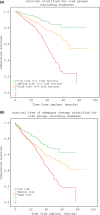Clinical risk profile score predicts all cause mortality but not implantable cardioverter defibrillator intervention rate in a large unselected cohort of patients with congestive heart failure
- PMID: 27800644
- PMCID: PMC6931818
- DOI: 10.1111/anec.12414
Clinical risk profile score predicts all cause mortality but not implantable cardioverter defibrillator intervention rate in a large unselected cohort of patients with congestive heart failure
Abstract
Background: Primary prophylactic implantable cardioverter defibrillator (ICD) therapy is indicated for patients with reduced left ventricular ejection fraction (LVEF). We aimed to determine if preoperative clinical risk profiling can predict long-term benefit, and if clinical risk scores can be applied and improved in a patient cohort outside the clinical trial setting.
Methods: Using registry data, 789 patients with reduced LVEF who received ICDs for primary prevention during 2006-2011 were identified (age 64 ± 11 years, 82% men, 63% ischemic etiology, 52% cardiac resynchronization therapy with defibrillator). The patients were divided into three risk groups, based on the presence of baseline clinical risk factors (age >70, QRS duration >120 ms, New York Heart Association class III-IV, atrial fibrillation history, or creatinine >106 μmol/L). Endpoints were all-cause mortality and survival free of adequate ICD therapy.
Results: Mean follow-up was 39 ± 18 months. Annual mortality was 7.6%, and increased with risk group (p < .001). Rates of appropriate antitachycardia pacing and shock therapy were not statistically different between the groups, and ranged from 11%-16% and 6%-14%, respectively. By combining the previous risk score with data on diabetes, a better independent prediction of mortality was achieved; mortality rates then ranged from 11% (low-risk) to 46% (high-risk) (p < .0001).
Conclusions: Implantable cardioverter defibrillator therapies occur across the spectrum of comorbidities in a population with systolic heart failure. However, all-cause mortality is considerably higher in the group of patients with accumulated risk factors, and using the proposed scoring system can be helpful for the evaluation and risk stratification of the patient prior to making a decision for a primary prophylactic ICD implantation.
Keywords: heart failure; implanted cardioverter defibrillator; primary prevention; risk score; sudden cardiac death.
© 2016 Wiley Periodicals, Inc.
Conflict of interest statement
The authors report no relationships that could be construed as a conflict of interest.
Figures


References
-
- Alter, P. , Waldhans, S. , Plachta, E. , Moosdorf, R. , & Grimm, W. (2005). Complications of implantable cardioverter defibrillator therapy in 440 consecutive patients. Pacing and Clinical Electrophysiology, 28, 926–932. - PubMed
-
- Bardy, G. H. , Lee, K. L. , Mark, D. B. , Poole, J. E. , Packer, D. L. , Boineau, R. , & Ip, J . (2005). Amiodarone or an implantable cardioverter‐defibrillator for congestive heart failure. New England Journal of Medicine, 352, 225–237. - PubMed
-
- Barsheshet, A. , Moss, A. J. , Huang, D. T. , McNitt, S. , Zareba, W. , & Goldenberg, I. (2012). Applicability of a risk score for prediction of the long‐term (8‐year) benefit of the implantable cardioverter‐defibrillator. Journal of the American College of Cardiology, 59, 2075–2079. - PubMed
-
- Bilchick, K. C. , Stukenborg, G. J. , Kamath, S. , & Cheng, A. (2012). Prediction of mortality in clinical practice for medicare patients undergoing defibrillator implantation for primary prevention of sudden cardiac death. Journal of the American College of Cardiology, 60, 1647–1655. - PMC - PubMed
-
- Buxton, A. E. , Lee, K. L. , Fisher, J. D. , Josephson, M. E. , Prystowsky, E. N. , & Hafley, G. (1999). A randomized study of the prevention of sudden death in patients with coronary artery disease. Multicenter Unsustained Tachycardia Trial Investigators. New England Journal of Medicine, 341, 1882–1890. - PubMed
MeSH terms
LinkOut - more resources
Full Text Sources
Other Literature Sources
Medical

